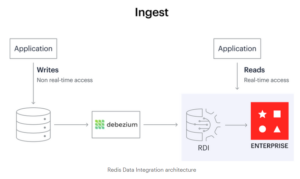
Redis Delivers First Big Release Under New CEO Trollope

(Gorodenkoff/Shutterstock)
Redis today unleashed a torrent of new functionality in the database, including vector search, native triggers, and a built-in change data capture capability, among others. The features reflect priorities that new CEO Rowan Trollope has brought to the growing NoSQL database vendor after joining the company in February.
Trollope arrived at Redis with some notches in his belt as a tech CEO, including four years as CEO of Five9 (FIVN), a video conferencing company that he took public and which is valued in the billions. But before accepting the Redis job, Trollope, who has 30 years of experience as a developer, took the database out for a spin.
After downloading the open source software, he used it to rearchitect the data store of an existing app. He liked what he saw, calling it “remarkable.” He also saw an opportunity for refinement in some places.
“My experience as a developer with databases was they were painful,” Trollope says. “I just want something that’s going to work, that’s going to be easy, that’s going to be seamless.”
The previous app that Trollope rearchitected was using Firebase, a mobile database that he termed “very complex.” That complexity was lacking in his Redis tryout.
“The core Redis OSS…is really, really phenomenal in terms of how easy it is to use, how delightful the API is, how straightforward it is,” Trollope tells Datanami. “There’s a handful of companies that get it really right. Stripe is a good example. The API is just a real beautiful thing, and I found that in Redis.”
Trollope was clearly intrigued by what he saw in Redis, characterizing it as a super-fast database with an elegant API. App users today demand quick loading times and rapid responses, and so he saw a tremendous growth potential for Redis, which had over 10,000 paying customers already, and many times that number using the open source product.
“That’s a big part of what I found appealing here is that, devs in general want to build apps that are faster and faster and faster,” he says. “There’s sort of like this perennial quest to make the fastest experience possible for their users, and rightly so–that’s what users want.”
Ofer Bengal, who had been Redis’ CEO since the company was founded back in 2011, decided it was time to hand the reins over to another CEO to finally get Redis over the hump: completing the long-awaited IPO. Trollope had that IPO experience, but the perspective of a developer to boot. However, Trollope realized it was not all rainbows and sunshine in Redis-land. Yes, the core technology was solid, but when you venture outside of the well-trod lanes, things get a little dicey.
“My experience with the technology out of the gate left me wanting a little bit at the edges of the experience,” he says. “…[W]hile the core was built by Salvatore [Sanfillippo] and by the Redis company, the edge of the experience–the SDKs and the integration and even the documentation–those were all built by the community. So as I visited upon this experience, it was far less than ideal.”
For example, the Redis company had no opinion, and gave customers no direction, on which software development kits to use. Instead, the default approach was to “read a bunch of random threads” on Stack Overflow.
“You’re kind of left to figure it out on your own as a developer and that’s not the kind of experience that you need if you’re going scale a technology like this so even greater heights,” Trollope says.
So for 7.2, Redis made a concerted effort to assemble the best SDKs for a variety of languages. This release features Jedis for Java, node-redis for NodeJS, redis-py for Python, NRedisStack for .Net, and Go-Redis for Go. In some cases, the company acquired the libraries, while in others, it brought the maintainers onboard as Redis employees. In either case, the idea is that new developers will have an easier time figuring out how to get productive.
Redis gets its speed from being an in-memory data store. But not everyone wants to put evefrything in DRAM, which is expensive. The company previously offered the capability to push some data into Flash solid state drives (SSDs).
With 7.2, the company rewrote Redis for Flash. The new version, dubbed Auto Tiering, will automatically move less frequently used data to SSDs, while offering twice the throughput of the previous version. Customers can save up to 70% of the costs they would incur if they kept all their data in DRAM, which will tamp down the temptation to look for other databases, Trollope says.
“That’s going to be a theme for us moving forward,” he says. “I heard it from a bunch of customers. They said, if you could give us a way to make certain workloads more cost effective, even if that means they’re little slower, we’re game… The more complexity you add to your application, the worse off you are. If you can do it with fewer tools and fewer platforms, that’s a good thing.”
Moving data into and out of Redis gets easier with version 7.2 thanks to a new feature called Redis Data Integration. Trollope likened RDI to a CDC-type of functionality that will enable customers to move data to and from Redis Enterprise and Oracle, Postgres, MySQL, and Cassandra in real time. The offering, which utilizes open source CDC from Debezium or other CDC technologies, supports a couple of use cases, including read-through cache and write behind, Trollope says.
Redis–which dropped “Labs” from its name back in 2021–has come a long way from being just a high-speed cache, and part of that is supporting higher order functions like triggers and functions. However, the database previously required engineers to know a language like C++ or Lua to use this capability. With 7.2, Redis is lowering the bar to tap into triggers and functions by allowing engineers to use JavaScript and Typescript to build them.
“So you can very easily extend Redis now and you don’t have to be a C++ programmer or learn a new language like Lua,” Trollope says. “You can very easily extend the platform and build capabilites using JavaScript.”
Last but certainly not least is the new vector search capability. Redis had been investing in building out its vector search capabilities for years before Trollope joined the Mountain View, California company. But the timing with the release of ChatGPT last fall spurred the company to get vector similarity search out the door.
Redis users can now use the database to store vector embeddings that they created by running their documents or images through an LLM managed by OpenAI, Microsoft, Google, or other provider. Storing these vector embeddings in Redis enables users to deliver a better, more customized experience to their customers via the search function on a website, chatbot interaction, or other AI use cases.
“What we found is that just a tremendous number of use cases [for vector search],” Trollope says. Chatbots are one popular use case, as is real-time face detection, he says.
As if adding vector similarity search wasn’t enough, Redis has also now made the search functionality multi-threaded. Going multi-threaded with the search capability is important, Trollope says, because search inherently relies on a scale-up architecture, rather than a scale-out architecture.
“The way that you scale search, actually–you can’t scale it horizontally,” he says. “You have to scale it vertically, because it’s a log scaling problem, not a linear scale, so therefore, having the ability to scale vertically is really important.”
Despite the large number of new gizmos to play with in 7.2, there is lots more on the way from Redis. “There’s more coming, absolutely,” the new CEO says. “There’s tons of needs from customers.”
There’s also an IPO in Redis’ future, but we’ll have to see when the market is ready for that.
Related Items:
Why Redis Needs Enterprise Developers
Redis Labs Gains VC Funding, New Enterprise Customers


































